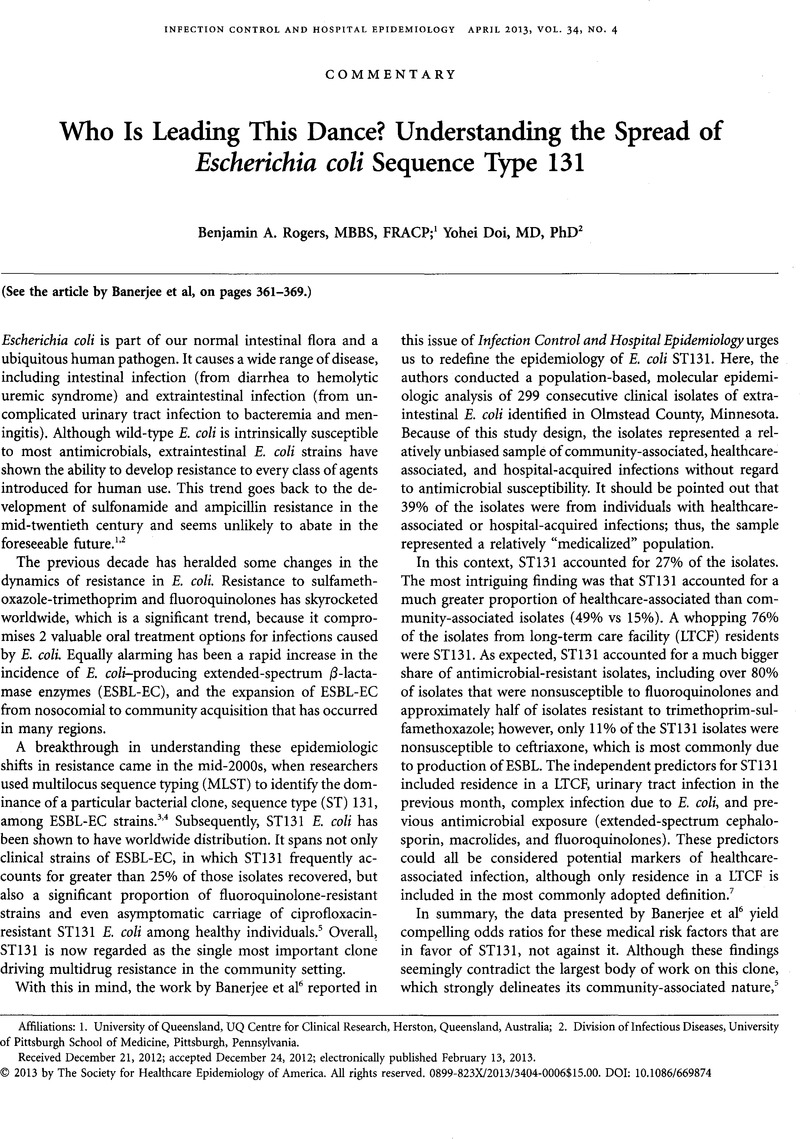Crossref Citations
This article has been cited by the following publications. This list is generated based on data provided by Crossref.
Rogers, Benjamin A.
Ingram, Paul R.
Runnegar, Naomi
Pitman, Matthew C.
Freeman, Joshua T.
Athan, Eugene
Havers, Sally M.
Sidjabat, Hanna E.
Jones, Mark
Gunning, Earleen
De Almeida, Mary
Styles, Kaylene
and
Paterson, David L.
2014.
Community-Onset Escherichia coli Infection Resistant to Expanded-Spectrum Cephalosporins in Low-Prevalence Countries.
Antimicrobial Agents and Chemotherapy,
Vol. 58,
Issue. 4,
p.
2126.
Ikram, Rosemary
Psutka, Rebecca
Carter, Alison
and
Priest, Patricia
2015.
An outbreak of multi-drug resistant Escherichia coli urinary tract infection in an elderly population: a case-control study of risk factors.
BMC Infectious Diseases,
Vol. 15,
Issue. 1,
Dautzenberg, M J D
Haverkate, M R
Bonten, M J M
and
Bootsma, M C J
2016.
Epidemic potential ofEscherichia coliST131 andKlebsiella pneumoniaeST258: a systematic review and meta-analysis.
BMJ Open,
Vol. 6,
Issue. 3,
p.
e009971.
Kim, Young Ah
Kim, Jin Ju
Kim, Heejung
and
Lee, Kyungwon
2017.
Community-onset extended-spectrum-β-lactamase-producing Escherichia coli sequence type 131 at two Korean community hospitals: The spread of multidrug-resistant E. coli to the community via healthcare facilities.
International Journal of Infectious Diseases,
Vol. 54,
Issue. ,
p.
39.
Sarowska, Jolanta
Futoma-Koloch, Bozena
Jama-Kmiecik, Agnieszka
Frej-Madrzak, Magdalena
Ksiazczyk, Marta
Bugla-Ploskonska, Gabriela
and
Choroszy-Krol, Irena
2019.
Virulence factors, prevalence and potential transmission of extraintestinal pathogenic Escherichia coli isolated from different sources: recent reports.
Gut Pathogens,
Vol. 11,
Issue. 1,
Batista, Rita
Saraiva, Margarida
Lopes, Teresa
Silveira, Leonor
Coelho, Anabela
Furtado, Rosália
Castro, Rita
Correia, Cristina Belo
Rodrigues, David
Henriques, Pedro
Lóio, Sara
Soeiro, Vanessa
da Costa, Paulo Martins
Oleastro, Mónica
and
Pista, Angela
2022.
Genotypic and Phenotypic Characterization of Pathogenic Escherichia coli, Salmonella spp., and Campylobacter spp., in Free-Living Birds in Mainland Portugal.
International Journal of Environmental Research and Public Health,
Vol. 20,
Issue. 1,
p.
223.





